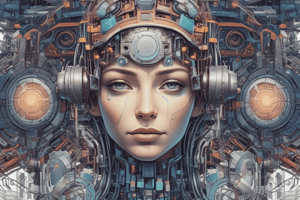Podcast
Questions and Answers
What is the primary goal of developing Artificial Intelligence?
What is the primary goal of developing Artificial Intelligence?
- To mimic human decision-making using structured and semi-structured data
- To build machines that can solve complex tasks like humans without using data
- To develop an intelligent system that can perform complex tasks (correct)
- To build machines that can learn from data to increase the accuracy of the output
What is the primary goal of machine learning in the context of the Google Nest device?
What is the primary goal of machine learning in the context of the Google Nest device?
- To enable the device to mimic human intelligence
- To teach the device to perform a specific task and provide accurate results (correct)
- To develop an expert system that can replace human intelligence
- To analyze live transit and traffic data to forecast the volume and density of traffic flow
What type of data can Artificial Intelligence systems work with?
What type of data can Artificial Intelligence systems work with?
- Only unstructured data
- Only structured data
- Only semi-structured data
- All types of data: structured, semi-structured, and unstructured (correct)
What is the relationship between AI and ML?
What is the relationship between AI and ML?
What is the primary goal of Machine Learning?
What is the primary goal of Machine Learning?
What is a key limitation of Machine Learning?
What is a key limitation of Machine Learning?
What is the overarching term that covers a wide variety of specific approaches and algorithms?
What is the overarching term that covers a wide variety of specific approaches and algorithms?
What is the main difference between AI and ML?
What is the main difference between AI and ML?
How do Machine Learning systems learn and self-correct?
How do Machine Learning systems learn and self-correct?
What is the scope of machine learning in the Google Nest device example?
What is the scope of machine learning in the Google Nest device example?
Study Notes
Artificial Intelligence (AI) and Machine Learning (ML)
- AI is a broader concept that enables machines or systems to sense, reason, act, or adapt like humans.
Artificial Intelligence (AI)
- AI aims to simulate human intelligence to solve problems.
- The goal is to develop an intelligent system that can perform complex tasks like humans.
- AI has a wide scope of applications.
- AI uses technologies to mimic human decision-making.
- AI works with all types of data: structured, semi-structured, and unstructured.
- AI systems use logic and decision trees to learn, reason, and self-correct.
Machine Learning (ML)
- ML is an application of AI that allows machines to extract knowledge from data and learn from it autonomously.
- ML aims to teach a machine to perform a specific task and provide accurate results by identifying patterns.
- The goal is to build machines that can learn from data to increase the accuracy of the output.
- ML has a limited scope of applications.
- ML uses self-learning algorithms to produce predictive models.
- ML can only use structured and semi-structured data.
- ML systems rely on statistical models to learn and can self-correct when provided with new data.
Key Differences between AI and ML
- AI encompasses a wide variety of approaches and algorithms, while ML is a specific approach.
- AI focuses on developing intelligent systems that can solve complex tasks, whereas ML focuses on teaching machines to perform specific tasks.
- AI has a broader scope of applications, whereas ML has a limited scope.
Studying That Suits You
Use AI to generate personalized quizzes and flashcards to suit your learning preferences.
Description
Learn about the relationship between Artificial Intelligence and Machine Learning. Understand how AI is a broader concept and ML is an application of AI.




